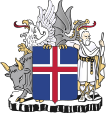| |||||||||||||||||||||||||||||||||||||||||||||||||||||||||||||||||||||||
All 35 seats in the Lower House and 17 seats in the Upper House of Althing | |||||||||||||||||||||||||||||||||||||||||||||||||||||||||||||||||||||||
| Turnout | 89.03% | ||||||||||||||||||||||||||||||||||||||||||||||||||||||||||||||||||||||
|---|---|---|---|---|---|---|---|---|---|---|---|---|---|---|---|---|---|---|---|---|---|---|---|---|---|---|---|---|---|---|---|---|---|---|---|---|---|---|---|---|---|---|---|---|---|---|---|---|---|---|---|---|---|---|---|---|---|---|---|---|---|---|---|---|---|---|---|---|---|---|---|
This lists parties that won seats. See the complete results below.
| |||||||||||||||||||||||||||||||||||||||||||||||||||||||||||||||||||||||
 |
|---|
|
|
Parliamentary elections were held in Iceland on 23 and 24 October 1949.[1] The Independence Party remained the largest party in the Lower House of the Althing, winning 13 of the 35 seats.[2]
Electoral system
The elections were conducted under rural–urban proportional representation. Twenty-one members were elected in single-member constituencies via first-past-the-post voting, while the remainder were elected using D'Hondt method proportional representation: twelve members in two-member constituencies, eight members in Reykjavík, and eleven from a single national compensatory list. To earn national list seats, a party had to win at least one constituency seat. In constituencies electing two or more members, within the party list, voters had the option to re-rank the candidates and could also strike a candidate out. Allocation of seats to candidates was done using a system based on the Borda count.[3]
Results
| Party | Votes | % | Seats | |||||
|---|---|---|---|---|---|---|---|---|
| Lower House | +/– | Upper House | +/– | |||||
| Independence Party | 28,546 | 39.53 | 13 | 0 | 6 | –1 | ||
| Progressive Party | 17,659 | 24.45 | 11 | +2 | 6 | +2 | ||
| People's Unity Party – Socialist Party | 14,077 | 19.49 | 6 | –1 | 3 | 0 | ||
| Social Democratic Party | 11,937 | 16.53 | 5 | –1 | 2 | –1 | ||
| Total | 72,219 | 100.00 | 35 | 0 | 17 | 0 | ||
| Valid votes | 72,219 | 98.35 | ||||||
| Invalid/blank votes | 1,213 | 1.65 | ||||||
| Total votes | 73,432 | 100.00 | ||||||
| Registered voters/turnout | 82,481 | 89.03 | ||||||
| Source: Nohlen & Stöver | ||||||||
References
- ^ Dieter Nohlen & Philip Stöver (2010) Elections in Europe: A data handbook, p961 ISBN 978-3-8329-5609-7
- ^ Nohlen & Stöver, p975
- ^ Renwick, Alan (2010). Helgason, Þorkell; Hermundardóttir, Friðný Ósk; Simonarson, Baldur (eds.). "Electoral System Change in Europe since 1945: Iceland" (PDF). Electoral system change since 1945. Archived (PDF) from the original on 4 October 2021. Retrieved 4 October 2021.








